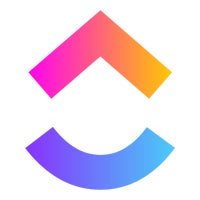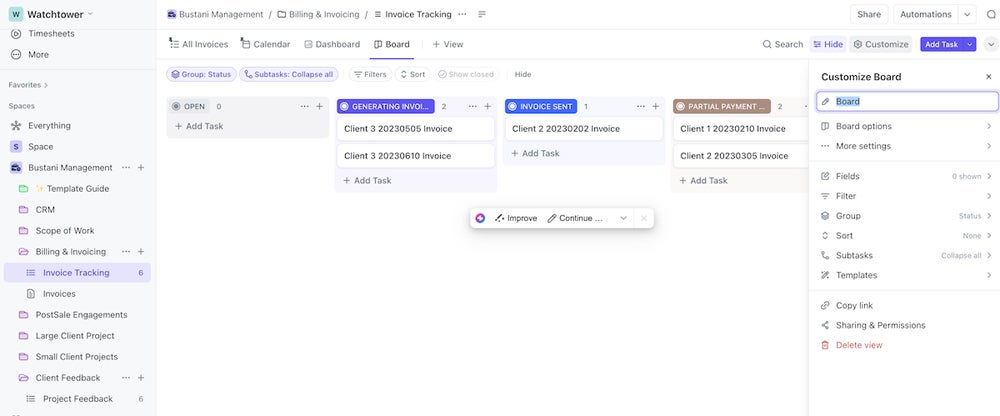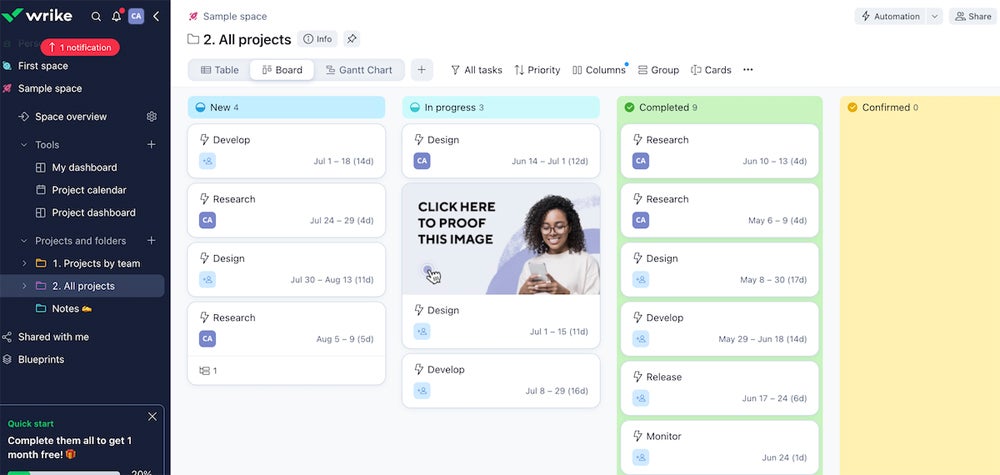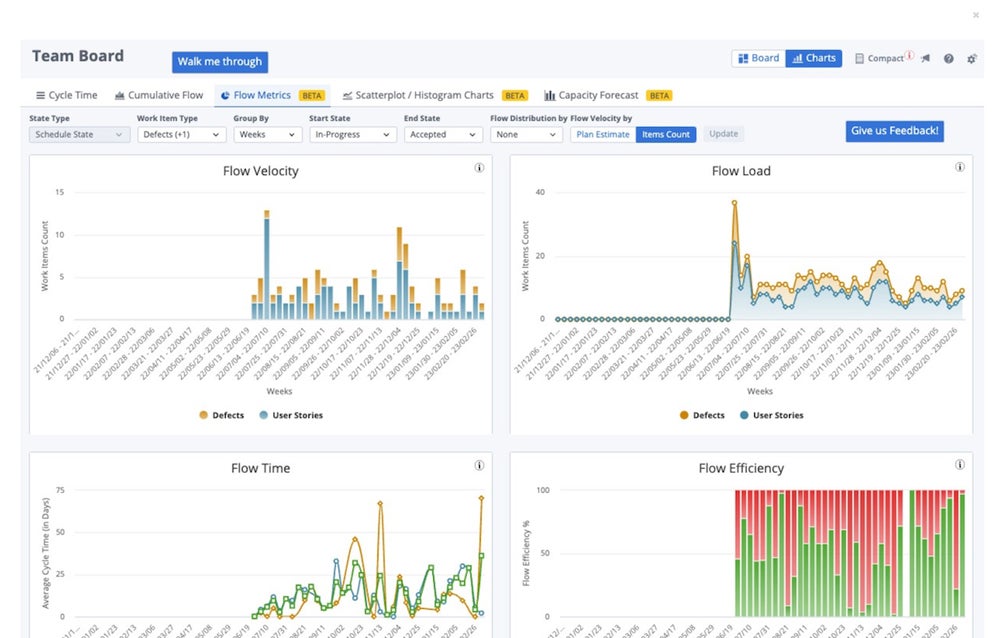Initially conceived to help teams transition from scrum to kanban, scrumban has evolved into a standalone hybrid project management methodology. As project requirements become more complex and fluid, scrumban’s hybrid approach offers a versatile solution for teams looking for more flexibility.
Here are eight of the best current project management software tools that support scrumban, compared against their key features, pricing and suitability for a variety of team needs.
- Best for software development teams: Jira
- Best for feature variety: ClickUp
- Best for visual collaboration: Miro
- Best for resource management: Teamwork
- Best for flexible scrumban workflows: Asana
- Best for scrumban automation: monday.com
- Best for complex projects: Wrike
- Best for enterprise scrumban management: Rally
1
Wrike
Wrike
Employees per Company Size
Micro (0-49), Small (50-249), Medium (250-999), Large (1,000-4,999), Enterprise (5,000+)
Medium (250-999 Employees), Enterprise (5,000+ Employees), Large (1,000-4,999 Employees)
Medium, Enterprise, Large
Features
Agile Development, Analytics / Reports, API, and more
2
Quickbase
Quickbase
Employees per Company Size
Micro (0-49), Small (50-249), Medium (250-999), Large (1,000-4,999), Enterprise (5,000+)
Medium (250-999 Employees), Enterprise (5,000+ Employees), Large (1,000-4,999 Employees), Small (50-249 Employees)
Medium, Enterprise, Large, Small
Features
Agile Development, Analytics / Reports, API, and more
3
monday.com
monday.com
Employees per Company Size
Micro (0-49), Small (50-249), Medium (250-999), Large (1,000-4,999), Enterprise (5,000+)
Any Company Size
Any Company Size
Features
Agile Development, Analytics / Reports, API, and more
Top scrumban project management software comparison
Here’s a comparison of top scrumban project management tools that highlights their ratings, best uses, starting prices and key scrumban features.
| Jira | ||||||
| ClickUp | ||||||
| Miro | ||||||
| Teamwork | ||||||
| Asana | ||||||
| monday.com | ||||||
| Wrike | ||||||
| Rally |
Jira: Best for software development teams
Our rating: 4.6 out of 5
Jira by Atlassian is a leading project management tool designed specifically for software development teams practicing scrumban. It seamlessly combines the structured sprint planning of scrum with the continuous flow and visual task management of kanban. This allows software development teams to customize workflows, set WIP limits and manage tasks efficiently. Jira’s robust reporting tools provide critical insights into team performance, making it easier to track progress and make data-driven decisions.
Why I chose Jira
I chose Jira because of its powerful features tailored for software development teams practicing scrumban. Its ability to manage both structured sprints and continuous task flows is essential for maintaining the dynamic nature of software projects.
The integration of kanplan, which blends kanban’s visual task management with scrum’s backlog grooming, offers a unique advantage in keeping projects organized and on track. Additionally, Jira’s extensive reporting tools, such as burndown and velocity charts, deliver valuable insights into team performance and project progress.
Pricing
- Free: $0 for up to 10 users.
- Standard: $8.15 per user billed monthly and $850 annually for 1–10 user tier.
- Premium: $16 per user billed monthly and $1,600 annually for 1–10 user tier.
- Enterprise: Available for teams with more than 201 users and only billed annually. Contact Jira Service Management sales for pricing information.
Standout features
- Custom workflows to match specific scrumban processes, blending sprint planning with continuous delivery (Figure A).
- WIP limits to maintain efficiency and prevent task overload.
- Kanplan to combine kanban’s visual board with scrum’s backlog, allowing for efficient backlog grooming and task management.
- Advanced reporting with burndown charts, velocity charts and cumulative flow diagrams for data-driven retrospectives and performance tracking.

Pros and cons
| Pros | Cons |
|---|---|
|
|
ClickUp: Best for feature variety

Our rating: 5 out of 5
ClickUp is a versatile project management tool with all sorts of features that support scrumban. It combines more than 15 views with structured sprint planning, which helps teams find that balance between flexible and organized project management. ClickUp’s highly customizable interface and vast feature set means its users can adapt their workflows to match all manner of project requirements, whether long or short-term.
Why I chose ClickUp
I chose ClickUp because of its huge feature catalog. For instance, its multiple views offered me variety for visualizing my workflows effectively, with the option of using its Board view as a scrum board to maintain the structured nature I needed. It also offers a task management kanban template to quickly get off the ground with kanban. ClickUp also delivers customizable task statuses and automation capabilities that streamline task management and improve efficiency.
Pricing
- Free plan available.
- Unlimited: $7 per user per month if billed annually, or $10 per user per month if billed monthly.
- Business: $12 per user per month if billed annually, or $19 per user per month if billed monthly.
- Enterprise: Custom pricing available for larger organizations.
Standout features
- Visualize tasks with the kanban Board view, allowing drag-and-drop management and customizable columns (Figure B).
- Custom task statuses for better workflow management, tailored to scrumban processes.
- Automation to reduce manual effort with rules for recurring tasks and status changes.
- Advanced reporting and dashboards to track progress and performance.

Pros and cons
| Pros | Cons |
|---|---|
|
|
Miro: Best for visual collaboration

Miro is a dynamic collaboration tool whose versatile visual project management features align with scrumban practices. Pairing the strengths of kanban boards and scrum methodologies, Miro gives users an infinite digital canvas for teams to visually organize tasks, brainstorm ideas and track project progress. This flexibility makes it particularly useful for remote and distributed teams that most appreciate a customizable visual platform to manage their workflows.
Why I chose Miro
Miro caught my eye because of its unique visual project management that flexibly converts sticky notes, shapes and text boxes into cards with information. This delivers an infinite canvas for expansive project mapping and brainstorming without space constraints, fostering creative and engaging collaboration. Plus, I found that Miro’s real-time collaboration and integration with tools like Jira and Slack made it more transparent and efficient for scrumban.
Pricing
- Free: Basic features for individual users or small teams.
- Starter: $8 per user per month billed annually or $10 monthly.
- Business: $16 per user per month billed annually or $20 monthly.
- Enterprise: Custom pricing available starting from 30 plus members.
Standout features
- Infinite canvas for limitless project mapping and brainstorming.
- Real-time collaboration to facilitate instant teamwork and efficiency.
- Customizable scrum templates and kanban boards (Figure C).
- Interactive brainstorming tools like mind maps and sticky notes.

Pros and cons
| Pros | Cons |
|---|---|
|
|
Teamwork: Best for resource management

Our rating: 3.7 out of 5
Teamwork is a robust project management tool with support for scrumban through detailed resource management capabilities. It enables teams to plan, track and optimize resource allocation with features like task dependencies, time tracking and workload management. Teamwork is also capable of visualizing workflows through customizable kanban boards and advanced reporting tools, which come in handy when managing resources across multiple projects and ensuring transparency.
Why I chose Teamwork
I chose Teamwork for its resource management as it best visualized resource allocation and tracked workloads, which helped me prevent bottlenecks in my project. With Teamwork, I can easily balance workloads, reassign tasks and monitor project progress to maintain a steady flow in scrumban projects.
Pricing
- Free: $0 for up to 5 users.
- Deliver: $11 per user per month if billed annually, or $13.99 per user per month if billed monthly.
- Grow: $19.99 per user per month if billed annually, or $25.99 per user per month if billed monthly.
- Scale: Custom pricing available for larger organizations.
Standout features
- Customizable kanban boards for visual task management and workflow optimization (Figure D).
- Sprint planning tools to help organize and execute sprints efficiently.
- Advanced reporting features for insightful project performance metrics.
- Time tracking and resource management to ensure optimal task allocation.

Pros and cons
| Pros | Cons |
|---|---|
|
|
Asana: Best for flexible scrumban workflows

Our rating: 3.9 out of 5
Asana is a versatile project management tool that aligns with scrumban by providing a flexible framework for managing tasks and workflows. The platform not only delivers both scrum and kanban software features but also moves seamlessly between these methodologies. Additionally, Asana has a customizable scrumban template and automation features that help teams optimize their workflows and improve productivity.
Why I chose Asana
Asana made it onto my list because of its scrumban-focused customizable template. Many tools support scrumban by providing scrum and kanban capabilities and direction on how to combine them intuitively. However, Asana takes this a step further with a scrumban template that includes directions on how to organize the information. This provides consistency when transitioning from one methodology to the other.
Pricing
- Basic: Free with limited features.
- Premium: $10.99 per user per month if billed annually, or $13.49 per user per month if billed monthly.
- Business: $24.99 per user per month if billed annually, or $30.49 per user per month if billed monthly.
- Enterprise: Custom pricing available for larger organizations.
Standout features
- Board view for visual task management and workflow optimization (Figure E).
- Custom fields to sort and filter work according to team requirements.
- Automation to streamline repetitive tasks and improve efficiency.
- Advanced reporting and dashboards to track project progress and performance.

Pros and cons
| Pros | Cons |
|---|---|
|
|
Standout features
- Customizable kanban boards to manage tasks and visualize workflows (Figure F).
- Sprint management tools for planning and tracking project progress.
- Automation features to streamline repetitive tasks and notifications.
- Advanced reporting and dashboards to monitor project performance.

Pros and cons
| Pros | Cons |
|---|---|
|
|
Wrike: Best for complex projects

Our rating: 4.6 out of 5
Wrike is a powerful project management tool that’s well-suited for complex projects thanks to flexible and robust features for both structured and adaptive workflows. It provides customizable online scrum boards, real-time collaboration tools and advanced reporting capabilities, allowing teams to manage complex projects with ease and transparency. Plus, Wrike’s focus on adaptability and continuous improvement makes it a great choice for teams needing to transition between different project methodologies seamlessly.
Why I chose Wrike
I found Wrike to be set up in the best way to handle complex projects. Its customizable online scrum boards allow teams to visualize their workflows and prioritize tasks, while the real-time collaboration tools enhance communication and teamwork. Additionally, Wrike’s automated reporting and analytics provide valuable insights into project performance, helping teams to continuously improve their processes and adapt to changing project requirements.
Pricing
- Free: $0 for up to 5 users.
- Team: $9.80 per user per month.
- Business: $24.80 per user per month.
- Enterprise: Custom pricing available.
- Pinnacle: Custom pricing available.
Standout features
- Customizable scrum boards to visualize and manage workflows (Figure G).
- Real-time collaboration tools to enhance team communication.
- Automated reporting and analytics for continuous improvement.
- Advanced time tracking and resource management features.

Pros and cons
| Pros | Cons |
|---|---|
|
|
Rally: Best for enterprise scrumban management

Rally, formerly CA Agile Central, is an enterprise-class agile development platform that’s well suited for large-scale scrumban implementations. The platform offers features such as customizable scrum and kanban boards, robust reporting tools and real-time visibility into work in progress. Its project tree and backlog management tools allow teams to visualize and manage tasks effectively.
Why I chose Rally
I saw Rally as a straightforward pick for large-scale agile project management. The platform’s customizable boards and real-time reporting tools provide a clear view of project progress and resource allocation, while its integration with CI/CD pipeline tools like Jenkins and SonarQube makes it more valuable in software development environments.
Pricing
Contact Broadcom sales for a quote as pricing information isn’t listed publicly.
Standout features
- Customizable kanban boards for visual task management and workflow optimization.
- Sprint planning tools to help organize and execute sprints efficiently.
- Advanced reporting and analytics to monitor project performance (Figure H).
- Comprehensive backlog management and project tree visualization.

Pros and cons
| Pros | Cons |
|---|---|
|
|
What is scrumban?
Scrumban is considered to be a hybrid agile project management methodology, which means it’s designed to break down a project into smaller tasks. It combines the visual and flow-focused strengths of kanban with the structure of scrum to enhance scrum’s flexibility. Scrumban is ideal for a team that is looking to work in sprints to produce a large quantity of deliverables.
How do I choose the best scrumban project management software?
To choose the ideal scrumban project management software, you’ll need to determine if it meets the needs of your specific use case. You can assess this by answering questions such as:
- Independent of its agile features, is the tool customizable enough?
- Does it integrate with your existing technology stack?
- Will its automation features help streamline the work you’re doing?
- Does it offer collaboration features that fit your team’s communication style?
- Is this tool scalable if your project needs change?
- How user-friendly is it, and will your team require training?
You also need to evaluate scrumban-specific features to make sure the tool is a good fit for your project needs and enhances your workflow.
Visual workflow management
Look for software that provides kanban boards where you can visualize your work and track the progress of tasks through various stages such as “Backlog,” “In Progress” and “Done.” This feature is useful for understanding the flow of work and identifying bottlenecks in real time.
Work-In-Progress limits
Choose tools that allow you to set limits on the number of tasks that can be in progress concurrently. This helps prevent overloading your team and ensures that members focus on completing tasks before taking on new ones. WIP limits ensure a manageable workflow and improve task completion rates.
Pull system
Opt for software that supports a pull system where team members can pull tasks from the backlog as they have the capacity to work on them, rather than being assigned tasks in advance. With this, you can expect greater flexibility as it allows team members to work at their own pace, which reduces stress and improves productivity.
Continuous improvement
Select tools that facilitate regular retrospectives and process evaluations, as they help teams identify areas for improvement and make necessary adjustments to workflows. Continuous improvement is a cornerstone of scrumban, which aims to see processes evolve and improve over time.
Flexibility
Ensure the software is flexible enough to adjust processes and workflows as needed. This is particularly important in dynamic, fast-paced environments. The tool should support easy modifications to task priorities, workflow stages and project timelines to accommodate shifting project requirements.
Methodology
The tools on this list were chosen by first assessing whether they offer agile features and then investigating their agile features to determine their approach to both scrum and kanban. I then tested the tools where possible to get a feel for the kanban and scrum features and compared them to the features they list on their web pages as well as the feedback these tools get from verified user reviews. From these, I was able to have a holistic picture of each tool and determine the strengths, weaknesses and differentiating qualities of each one.






